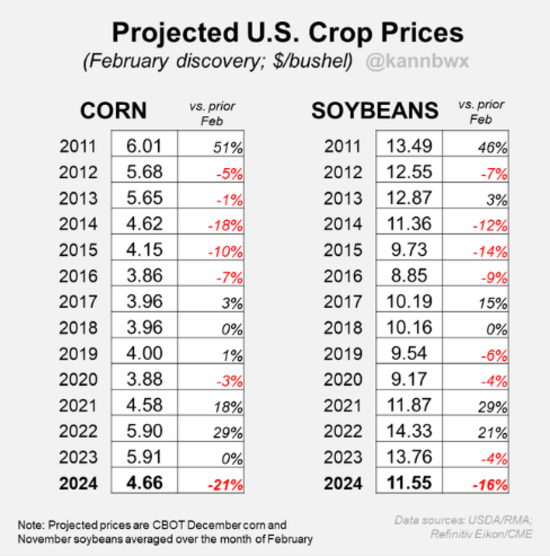By Ryan Hanrahan, University of Illinois’ FarmDoc project
Progressive Farmer’s Katie Micik Dehlinger reported Thursday that “the corn projected price for 2024 revenue protection policies is 27% lower than last year at $4.66 per bushel, while the soybean projected price is 16% lower at $11.55. Projected prices for spring wheat are $6.85, 30% lower than last year.”
“Revenue protection crop insurance policies won’t cover the cost of production for many farmers in 2024, leaving many vulnerable to financial losses in the case of drought or severe declines in commodity prices,” she wrote.
“Crop insurance policies that guarantee prices for the 2024 growing season are the lowest since 2021 for corn and the lowest since 2020 for soybeans, reflecting ample supplies of those crops left from last year’s harvest and soft demand, analysts said,” according to reporting from Reuters’ Julie Ingwersen.
“Revenue protection insurance products use the average daily closing price of new-crop futures contracts — December for corn, November for soybeans and September for spring wheat — to establish revenue guarantees,” Micik Dehlinger reported. “Farmers are paid an indemnity when prices or yields drop enough to cause calculated revenue to fall below the guarantee. Farmers also select a coverage level between 70% and 85%. The higher the coverage level, the lower yield or price losses need to be to trigger a payment. Higher coverage levels also carry higher premiums.”
Farmdoc daily’s Nick Paulson reported on Friday that “lower projected prices result in lower minimum revenue guarantees for revenue policies like revenue protection and revenue protection with the harvest price exclusion. While the yields that can be guaranteed using policies like yield protection are not impacted, the value of any payments on yield losses is reduced.”
“For instance, if a farmer purchases an 85% coverage policy and produces average yields, it would take prices falling to $3.96 on corn, $9.81 on soybeans or $5.81 on spring wheat to trigger an indemnity, (DTN Lead Analyst Todd) Hultman said,” according to Micik Dehlinger’s reporting. “At 80% coverage, those fall to $3.72 for corn, $9.24 for soybeans and $5.47 for spring wheat.”
“On the positive side, the lower projected prices for 2024 will also result in lower premium costs,” Paulson said. “…While lower premium costs might be a welcome relief given the lower insurance guarantees available this year, producers may also want to consider available options to increase their coverage for greater protection given the higher production costs and margin squeeze. This could be achieved by increasing the coverage level on your typical policy if you are not already at the highest available level.”
“‘My best advice is to get crop insurance,’ Hultman said,” according to Micik Dehlinger. “‘At these lower prices, the good news is that crop insurance will be less expensive this year. The bad news is it’s not protecting a very good price.'”



